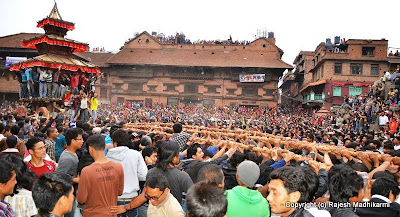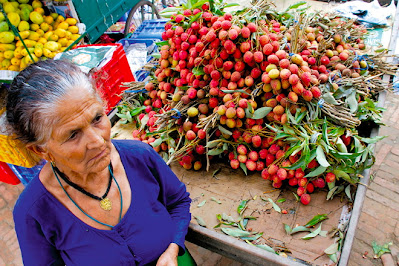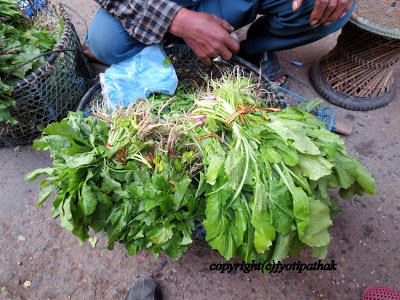The Greatest Festival of Nepal - Bisket Jatra of Bhaktapur भक्तपुर (2069-2070 B.S.)
 |
| A grand festival of Bhaktapur - repertoire of cultural experience... |
Festivals are an integral part of life in Nepal, and numerous festivals held throughout the year are enthusiastically supported by the Nepalese people. Religious festivals are determined by the lunar calendar, while national festivals have fixed dates. There is one festival, however, which is determined by the solar calendar. This is the annual Bisket Festival, which takes place in early April in the ancient Newari Cultural City of Bhaktapur – and it is based on a fable.
Bhaktapur, the cultural capital of Nepal, is rich for its culture, heritage, traditional feasts and festivals and typical Newari life style. It is worthwhile to visit Bhaktapur especially when you can watch a live festival. The biggest festival of Bhaktapur is called ‘BISKET JATRA’. This year, it starts from 10th of April for a week. For the festival, people have started making Bhairab chariot and Bhadrakali chariot. The chariots will be pulled during the festival at Taumadhi square, Bhaktapur. They will be pulled by both sides of the chariot like a game tug of war.
Then there will be competition between the two parts of this ancient city called upper part (Thane) and down part (Kwone). It is so amazing to watch the chariot pulled by both sides. At that moment people get so excited and with full of enthusiasm; they enjoy watching and pulling the chariot. The sound produced by pulling in full motion is just fantastic!!!
Because the nine-day Bisket Festival takes place over the period of the Nepalese New Year of Bikram Sambat, it is regarded as a New Year Festival as well. The festivities start off with a friendly tug-of-war between the residents of the lower and upper halves of the town of Bhaktapur, during which each group tries to pull an historical chariot containing an image of Betal and Bhairab to their side of the town. The festival includes parades, procession and the display of temple deities throughout the city. On the fourth day of the festival, and the last day of the “old year”, the men of the city work together to raise a approximately 25 meter high ceremonial pole, locally called "Yosing Dyo", into place. The pole has a crossbeam with two strips of cloth called "Halin Patta" hanging from it as a representation of two slain snakes. This ceremonial pole stays up until the following day when residents of the lower and upper halves of the city once more engage in a tug of war, but this time to pull the pole down to their respective sides. Once the pole crashes to the ground (sometimes resulting in casualties) it is seen as the official beginning of the New Year and the festivities continue for four more days.
The Bisket Festival of Bhaktapur is based on the story of a Bhaktapur King’s quest to find a husband for his daughter. Each time he made a suitable match, the groom would be found dead in the marital bed the following morning. Eventually eligible bachelors became a scarce commodity and the people prayed earnestly for deliverance from this mysterious curse. One day the father of the next prospective groom, on learning of the curse, offered to take his son’s place in the marital bed. Forcing himself to stay awake and alert following the consummation of the marriage, the substitute groom saw two deadly serpents slithering out of the princesses’ nostrils. The hero quickly killed the snakes and broke the spell, thereby earning the undying gratitude of the people and resulting in the celebration of the Bisket Festival.
Visitors to the beautiful city of Bhaktapur will more than likely be able to witness, and even share in a festival, no matter what time of the year they choose to travel here. Joining in the celebration of the Bisket Festival in April is sure to be an exciting and unforgettable experience for their entire life........ continue reading more here.
This week's pictorial blog takes us to the most beautiful and ancient city of Bhaktapur to celebrate Bisket Jatra. I would like to thank Rajesh Madhikarmi, for letting me share his pictures in the blog. Rajesh is a very creative and talented photographer and his interest lies in capturing people and emotions. He was born and brought up in Bhaktapur and is currently living there. Visit his Facebook page "Lets SEE Through my Eyes." by clicking here. My thanks goes to our friend, Prof. Yogendra Jonchhe, another native of Bhaktapur, for providing me the official brochure of Bhaktapur Bisket Festival (jatra) and Madhyapur Thimi Bisket Festival (sindoor jatra). The excerpts and write-ups are taken from the official page of Bhaktapur tourism department and Nagarpalika pages. Khwopinggram is the ancient name of Bhaktapur. The term "Bhaktapur" (भक्तपुर in Nepali-Sanskrit) refers to "The City Of Devotees". This Bhaktapur City is also known as Khwopa (ख्वप in Nepal Bhasaa) or "Bhadgaon" (भादगाँउ in Nepali) or "Ancient Newari Town" throughout the Kathmandu valley - source
If you would like to read more about this grand festival, here are some of the useful informative links and webpages:Bhaktapur - Wikipedia - please click here.
The Greatest Festival of Nepal "Bisket Jatra of Bhaktapur" - please click here.
Nepali New Year and Bisket Jatra - please click here.
Bisket Jatra: a guide to celebrating Nepali New Year (Lnewnepaldream) - please click here.
Hole in the Donut Cultural Travel - connecting the world through storytelling by Barbara Weibel - please click here.
Explore Himalaya Tourism News, Trip Reports, Travel Guide & Photos - please click here.  |
| ... sharing the lively spirit of festival time in Bhaktapur - the sight of decorated chariot is being pulled.... |
 |
| ... young accomplished flute players during the festival time ... |
 |
| ... the leading musician with dhakaa topee (Nepali traditional hat), flower in his ears, busy playing the classic instrument tabalaa in the packed courtyard of Bhaktapur festival site ... |
 |
| ......thousands of people come to Bhaktapur from every corner of Nepal to watch the festival ... |
 |
| ...most elaborate Nepali New Year celebration ... |
 |
| ... procession continues ... |
 |
| ... spectators watching Bisket Jatra - young children climbing on a statue ... |
 |
| ... the lady in the red is carrying a tray full of offerings for the deity ... |
|
 |
| ... night time view of the chariot being pulled at the Bhaktapur courtyard area and the narrow stone-paved streets - no one should miss the festival of Bisket Jatra ... |
 |
| ... experience the most authentic and traditional Newari festival of Bisket Jatra ... |
 |
| ... everyone is in festive mood ... one hundred different reason to love Nepal's cultural heritage ... |
 |
| ...the chariot is being pulled slowly by holding a thick rope that is attached to the chariot.... |
 |
| .... everyone is participating to push the chariot ... |
 |
| ... a big tug of war - between two sides - the winners are considered blessed and it brings good luck and fortune to them for the coming New year ... |
 |
| ... wonderful photo shot by Rajesh Madhikarmi - a man sitting underneath the wooden chariot to check the rope.... |
 |
| ...festival music and musical instruments .... |
 |
| ... local musicians playing all kind of instruments ... |
 |
| ... decorating and giving the finishing touch to the big wooden chariot wheels ... |
 |
| A guide brochure - celebrating Bisket Jatra from Bhaktapur, Tourism Department Committee, Taumodhi, Bhaktapur, Nepal |
 |
| Itinerary of the festival - let's celebrate Bisket Jatra peacefully .... |
 |
| Newspaper clipping Kantipur |
|
- Nepali New Year and Bisket Jatra - The famous Bisket Jatra, generally celebrated by locals of Bhaktapur for nine days and eight nights in every New Year as per the established tantrum method has begun on Monday for this year.
Mainly, a pole decorated with the banner of Lord Indra will be erected on the last day of Chaitra and it is pulled down in the evening the following day (Nepali News Year´s Day) after marking the Lingo Jatra with fanfare at Bhelukhel, Bhaktapur.
The Jatra that dates back to the Lichchhibi period starts with the procession of chariot carrying the palanquins of Hindu deities across the town square.
In one of the most exciting annual events in the Kathmandu valley, a huge chariot carrying images of the god Bhairab is hauled by locals to Khalna Tole. The creaking and swaying chariot lumbers around town, pausing for a huge tug of war between the eastern and western sides of town.
After the battle the chariots head to Khalna Tole, where a huge 25m-high pole is erected in the stone base. RSS
|
Bhaktapur at a Glance
Established in the 8th century A.D
Total municipal are of Bhaktapur 6.88 sq km
Population density on an average 145 per/ha.
Main occupation of inhabitant- Agriculture
Secondary occupations are waving, woodcarving, metal crafts, clay work and stone carving business5_storied_temple
Only producer of Nepali National Cap.
Famous for good Yogurt production
Enlisted in the World Heritage list in 1979
Example of living heritage & medieval town of the Newars.
“The cleanest and least polluted city in the country.”
Decorated with the Peace Award of the UNESCO in Asia and Pacific in 1999.
First City in the Country to launch college with science, management, engineering& architecture stream for the community in the modest tuition fees.
E.A. Powell’s (London) observation – “Were there nothing else in Nepal save the Durbar Square of Bhadgaon (Bhaktapur), it would still be amply worth making a journey halfway round the globe to see”...... source - Bhaktapur MunicipalityCopyright Information
All information on the Taste of Nepal blog are restricted use under copyright law. You may not re-use words, stories, photographs, or other posted material without the explicit written consent and proper credit to newnepaldream.blogspot.com. If you would like to use any materials here, please contact me.



.jpg)


























Comments
Post a Comment